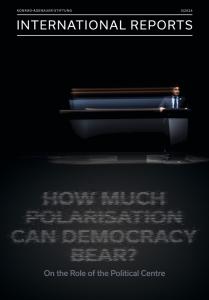Issue: 3/2024
Dear Readers,
The “centre” is booming this year, especially from an international perspective, if not in the form of good election results, then at least in the form of increased attention, which is generally fed by concerns about its supposed or actual erosion in many democracies around the world.
But what do we mean when we speak of the “political centre”? How can we define it? Who are its opponents? And what can be done to strengthen it? This issue of International Reports cannot provide exhaustive answers to these questions. What it does offer, though, are well-founded case studies, including from regional contexts that are less often highlighted in the German press.
These studies do not give rise to a uniform picture of what the “centre” constitutes, and that is hardly surprising. In India, for instance, different benchmarks apply to centrist politics and policies than in Chile, as the articles by Lewe Paul and Ashutosh Nagda, and by Olaf Jacob in this edition show. What is more: even within a specific country, the notions of what the extreme-right, the extreme-left and the centre mean, can significantly shift over time.
Nevertheless, common ground can be identified for the political present, that distinguishes centrist parties from the forces on the fringes of the political spectrum, at least in tendency. The centre leans towards integration, whereas the fringes tend towards division and often fuel this deliberately. Centrist parties and their personnel may have clear positions of their own, but they also know that compromises are needed in plural societies and are part of the normal democratic “business”. Extreme political forces, on the other hand, often regard compromise as betrayal. They exaggerate social lines of conflict, identify enemy groups – “the elite”, foreigners, minorities of all kinds. They call for the supposedly homogeneous will of the “true people” to be radically enforced.
Hardly any party today calls for the abolition of democracy. However, parties far from the centre – in their programmes and, once in government, in practice – have at least an ambivalent relationship towards liberal, constitutional democracy that protects minorities and the political opposition from the “tyranny of the majority”.
Especially when we consider the question of where the threat to the democratic centre comes from, looking beyond Europe proves to be insightful. It is true that in many European countries, among them Germany, right-wing populism and extremism currently pose the greatest challenge to liberal democracy. But it is also true that in Latin America, for example, most of the “successful” attacks on democracy in the past quarter of a century came from the left.
In his article, Sebastian Grundberger highlights how moderate and radical left-wing players have organised themselves into an entire “pink galaxy” that systematically shields “their” autocrats in Latin America against international criticism, increasingly undermines the democratic left, and sees itself as a global political ally to all countries that want to push back the power of Western states and the influence of liberal values internationally. In fact, many, though explicitly not all, parties from the left-wing and right-wing fringes in Latin America and Europe are united by a proximity to revisionist authoritarian states such as Russia and China.
There are no simple answers to the question of what strengthens and what weakens the democratic centre in a country. For instance, rampant polarisation has been cited as an evil in many democracies for years. In fact, there are states such as Georgia, where – as analysed by Stephan Malerius in his article – polarisation between the political camps has reached a stage at which it prevents constructive debate on the country’s actual problems and results in enormous dissatisfaction among the population. On the other hand, it is important for parties in the political centre to remain sufficiently distinguishable from one another, as Ludger Gruber and Martin Friedek illustrate in their article on Spain.
When people talk about the rise of the political fringes, they often complain about the role of new media, which are said to favour extreme opinions, brutalise discourse and give populist parties a boost. While this may be true, this observation should not obscure our view of one thing: the rise of populist parties is not just a “discourse effect”, but is often also the result of a “performance deficit” on the part of centrist parties. There are actual problems that concern many citizens and to which the aforementioned parties have failed to provide convincing answers in the recent past. With a view to France, Anja Czymmeck and Nele Wissmann speak of a climate of pessimism and a worrying loss of trust in the established political forces. This is even more pronounced in Argentina, as Jana Lajsic illustrates in her text on the rise of the “anti-system candidate” Javier Milei. The observation can probably be applied, to varying degrees, to a number of other democracies.
It is not wrong to warn of the dangers posed by populists and extremists on both the right and left. However, after everything we have experienced in recent years, there is reason to doubt the broad impact of such warnings. This makes it all the more important for centrist parties to find workable solutions to the issues that people perceive as relevant to their lives. From a political science perspective, centrist parties should strengthen their output legitimacy instead of insisting on their higher input legitimacy. In everyday language, we would say that they should deliver, as opposed to spending more energy on presenting themselves as the better democrats, even if they actually are. It goes without saying that they cannot offer the same simplistic “solutions” as their populist opponents. However, the least that citizens can expect is that centrist parties do not ignore problems because they are not provided for in their political ideal.
I hope you find this report a stimulating read.
Yours,

Dr Gerhard Wahlers is Editor of International Reports, Deputy Secretary General and Head of the Department European and International Cooperation of the Konrad-Adenauer-Stiftung (gerhard.wahlers@kas.de).
Topics
Austria's political centre under pressure
Elections in Greenland
Bundestag election 2025: France hopes for policy change in Germany
No clear winner in the parliamentary elections in Kosovo: Forming a government will be complicated
Canada faces the threat of a trade war with the U.S. in this election year!





